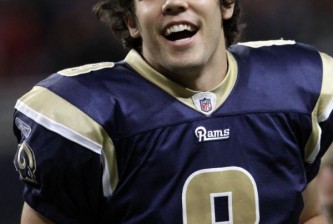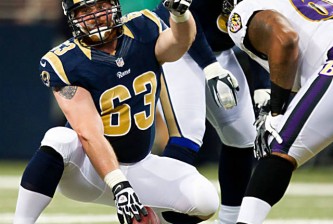Bernie Miklasz plays devil’s advocate in his latest column, and lists five reasons why Bradford-to-St Louis is not yet a done deal. Most frightening to St Louisans? The prospect that, like John Elway and Eli Manning before him, Bradford could be drafted by the Rams but refuse to play for them.
— stltoday.com: “Why Bradford isn’t a lock“
I think we all remember the Manning case well, but Elway’s story stretches back to my pre-teen years, when football was pure heroic spectacle without any messy business negotiations or player unrest. (The player strike of 1982 meant very little to me — I couldn’t understand why anyone wouldn’t want to wear the uniform of a professional team, even one as pitiful as my hometown Buccaneers.) As it turns out though, Elway was one of the dynamic young players that helped rebuild fan affection for the game after that strike — even as the Colts became the league’s pariahs for abandoning Baltimore.

Are these players, and the teams that drafted them, in similar positions? Let’s review some of the articles of the time:
In 1983, Elway had plenty of options to use as bargaining leverage against the Colts — the USFL, the Canadian Football League, and even an offer to play for the New York Yankees. This last option was especially potent, as Elway could become an unrestricted free agent in the NFL after spending just two years outside of professional football.
Says Steinbrenner, “I put an old scout, Dutch Dotterer, on John [Dotterer’s grandson, Mike, is also a major league prospect, as an outfielder, and played in the same football backfield with Elway at Stanford]. Dutch reported he has an outstanding arm, is a fine defensive player, will hit with power and is a great competitor. He’s rated a definite. I see a lot of Mickey Mantle in him….
NFL men are no less admiring. Dick Steinberg, the New England Patriots’ personnel director, says Elway has “no flaws.” Gil Brandt, the Dallas Cowboys’ personnel chief, says if he had Joe Montana, Dan Fouts and Danny White on his team, he’d still pick Elway No. 1.
Ralh Wiley, SI: “Would he rather be a Unitas or a Mantle?“, April 11, 1983
Bradford, by comparison, has been fighting uphill against perception since his decision to forgo last year’s draft and play his Senior year at Oklahoma. He doesn’t have the pure arm strength or mobility of Elway, though his ability to see the field and deliver on-target throws is rated at the “elite” level. But as far as we know, not even the lowly Washington Nationals have come calling for his services.
On draft day, Elway made his move. And the business ramifications for the players union of the time — then too spineless to fight for free agency for their players — are staggering.
After Elway repeated his vow to play for the Yankees rather than the Colts, Dick Berthelsen, the NFLPA’s staff counsel, took pains to clarify an important point. If Elway were to sign with either the Canadian Football League or the USFL, Berthelsen said, the Colts would retain his NFL rights for four years. But if Elway went with the Yankees, he could become an NFL free agent following the 1985 draft. “The language in the agreement is very specific on that,” Berthelsen said. “If he does not play professional football, he would be a free agent after two years.”
Berthelsen’s keen interest in setting this matter straight is curious. In recent years, the NFLPA has refrained from pushing for free agency for its players and has even negotiated away major gains on the issue that the players had won in court….
Conceding that free agency “presumably” would be of considerable benefit to Elway, he adds, “There aren’t too many people who would be in the same position, though. As a general proposition, I would say that only one or two percent of the players are in a position to benefit from free agency, players who have the potential to be franchise-makers, like Elway.”
Jerry Kirschenbaum, SI: “Caveat Draftor,” May 9, 1983
Ironically, Bradford finds himself in a similar circumstance, as the players’ union and owners’ group gird for a bitter showdown over free agency, shared revenues, and the potential for a cap on rookie salaries. Bradford is being touted by many as the one “franchise quarterback” in this draft (whether or not we agree), and as the presumptive #1 his record-setting contract may be put in the crucible of this debate.
Ultimately though, the showdown between Elway and Baltimore was resolved in a late-night deal with Denver. And the fates of two franchises changed dramatically.
- In hopes of keeping Elway from casting his lot with either the Yankees or, worse, the USFL, Commissioner Pete Rozelle, ordinarily a non-interventionist in such matters, took the unusual step of saying that if the parties desired, he’d help “in any way I can” to arrange a trade between the Colts and an NFL team interested in Elway.
- Al Davis, the Raiders’ managing general partner and Rozelle’s courtroom nemesis, threatened to bring yet another lawsuit against the NFL, this one alleging that before the draft Rozelle had vindictively sabotaged a three-way deal with the Bears and Colts that would have brought Elway to the Raiders.
- Rozelle said Davis was driven by “calculated paranoia.” Bears General Manager Jim Finks called Davis “absolutely crazy.” According to Davis, it was Finks who, at Rozelle’s behest, scuttled the deal that had Elway ticketed for the Raiders.
- Colts owner Bob Irsay stunned the football world by making the Elway trade, one of the biggest in NFL history, over the heads of his own GM, Ernie Accorsi, and coach, Frank Kush, both of whom learned about the consummation of the deal from the media.
The commotion was heightened by the widely voiced assertion that Irsay had been taken to the cleaners by the Broncos. The fact is, given the Colts’ alternatives, the deal may not have been as bad as Irsay’s detractors made it seem. In return for Elway the Broncos gave the Colts their rights to Northwestern Tackle Chris Hinton, the fourth overall pick in the draft; to backup Quarterback Mark Herrmann; and to their first-round pick in 1984.
Jerry Kirschenbaum, SI: “The Colt-Bronco Horse Trade“, May 16, 2983
In St Louis, it won’t be the owner who pushes this trade through, as the ownership seat currently sits empty. But that package of players and picks is remarkably similar to the package proposed by Peter King in yesterday’s MMQB.
The Broncos parlayed a tandem of their immobile-but-competent veteran Steve Deberg and the raw-but-electric Elway into a 9-7 season and a playoff spot that pushed the Broncos’ #1 pick the following year from 4th overall all the way down to 19th.
The Colts, meanwhile, ended up with offensive guards from both first-round Denver picks, and took a safety with their own high #1 in 1984, eschewing skill players despite starting a guy named “Pagel” at quarterback.
Ironically, the Colts and Broncos both improved their records by 7 games from ’82 to ’83 (the Broncos from 2-7, the Colts from 0-9), but while Dan Reeves and John Elway made a perennial playoff pair, the Colts failed to hold on to their gains, and the coaching staff was fired midway through the 1984 season — their first after bolting from Baltimore in the dead of night.
Only time will tell whether the Bradford-Elway comparison extends this far.






















